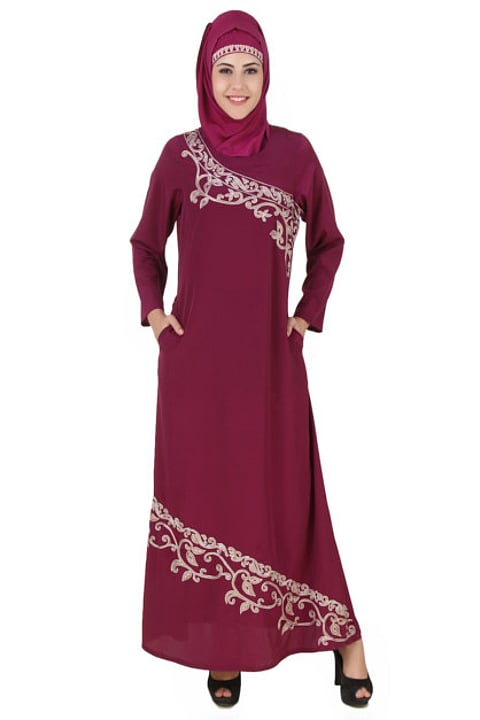A traditional attire gets a makeover
There’s a growing demand for stylish abayas in India’s metropolitan cities due to the advent of e-commerce

New Delhi: The abaya, the Muslim woman’s traditional garment, has gone chic. The loose-fitting, full-length robe, traditionally worn in black colour, has undergone a makeover in shades of blue, green, pink and other hues.
A growing demand for abayas in India’s metropolitan cities due to the advent of e-commerce has penetrated places including, Andaman & Nicobar Islands, Jammu & Kashmir, Odisha and Telegana. Until a few years, the options for abaya styles were limited n India , but as fashion houses woke up to the potentail of making abayas into stylish statements, there was no stopping e-commerce portals such as Islamicshop.in, Mybatua.com, Littleblackhijab.com, Limeroad and ShopClues that are doing brisk business.
As Chennai-based Mohammed Maaz, founder and CEO of Islamicshop.in said: “Women want to achieve sartorial ambitions along with traditional dressing, hence they select out-of-the-box options in abayas that are beautiful, unique, versatile and contemporary.”
Having set-up business in 2015, Maaz has associate production units in different cities across India. Availability of both manpower and variety of fabrics, in addition to aspiring and established designers offering their products, led him to cater to an enviable clientele in the age group that comprises teenagers to women in their 30s. Though majority of the orders come from big cities, Maaz says he has also been receiving orders from semi-urban and rural areas.
Recognising the scale of opportunities, Indian cloth manufacturers are now offering abayas in a wide range of fabrics including cotton, lycra, nida (polyster), rayon, georgette, crepe and denim. These are mostly embellished and hand-embroidered with glass, stones, crystal beads, sequins, zardozi, lace and silk thread. Some still show preference for simple abayas with dual tones that amplify their beauty.
Having customers both in domestic as well as international markets, Maaz informs, “With orders from across the globe (majority from the US, UK and Canada), we witness soaring sales during the months of Ramadan and Zul-Hijjah (the month of pilgrimage and the festival of sacrifice). In India, while women from northern states choose bright colours and designs, women residing in southern states often go for somber shades.
“Be it college going students or office goers, women want to stand out in whatever they wear. So, keeping in view the choices of today’s generation, we keep a collection of different contrasts and combinations in design. The price ranges between Rs.1,000 to Rs.25,000.
Designs and colours aside, women choose abayas based on fabrics that suit the weather conditions. Women in Western countries usually opt for denim, jersey, satin and woven abayas that can keep them warm. For women living in warmer regions, the preference is flowy abayas in cotton, rayon, linen and viscose.
Umang Goel of Mybatua.com explains, “Abayas are of two types – one, that is worn as a dress and two, which is worn as a gown to cover other outfits. We made modifications keeping in mind the climatic conditions of consumers. For instance: we manufacture abayas in light colours using breathable fabrics for women residing in hot and sultry regions. Often, orders come from young working women, who prefer ankle-length abayas that can be worn on top of jeans, trousers and leggings. These not only look smart at a work place, but also are very comfortable.”
Along with his father Amrish Goel, Umang started the brand in 2012, selling about 5,000 abayas a month to mostly urban buyers in the age group of 25 to 55 years. He informs, “Since we sell worldwide, the colours and design keep changing according to the trends that are in vogue in various parts of the world. So, creating new designs is a continuous process. However, the demand for the classic black abaya is always high. Our price range is between Rs.1,000 to Rs.10,000.”
In recent years, brands including Marks & Spencer, Dolce & Gabbana, H&M and Mango have catered to modest dresses for the discerning buyers.
Nandini Sen, 31, New Delhi
“An elegant attire, abayas are just the thing for me. I bought my first abaya last year and ever since, the collection is only growing. I like feminine floral and geometric prints, and kaftans look really chic on me. While a bit of lace on the sleeves and collars add a hint of the Victorian charm, a well-cut elegantly designed mono-coloured abaya can be equally attractive. My personal favourites are the eye-catching lurid ones in deep red and fuschia pink. And prefer fabrics like lycra, nida, rayon and viscose, as they are flowy and do not crease.
Anam Farzeen, 27, Chennai
“Since Chennai has few traditional retail stores, there’s always a high chance of running into someone wearing similarly designed abaya. But with online platforms that not only offer many options, but also customise abayas, it’s now easy to experiment with new designs. Because it’s summer throughout the year in the state, I prefer abayas in rayon and viscose, as these are light, soft and airy. Opting for shades such as brown, black, grey and maroon, I feel comfortable in straight cut, umbrella or kaftaan type abayas. I team them with coloured scarves or printed hijabs, often using brooches and pins for effect.”
$243 billion: Muslim consumer spending on apparel topped $243 billion in 2015, with an expected increase to over $368 billion by 2021, according to Thomson Reuters State of the Global Islamic Economy 2016-17 report.
Sign up for the Daily Briefing
Get the latest news and updates straight to your inbox


